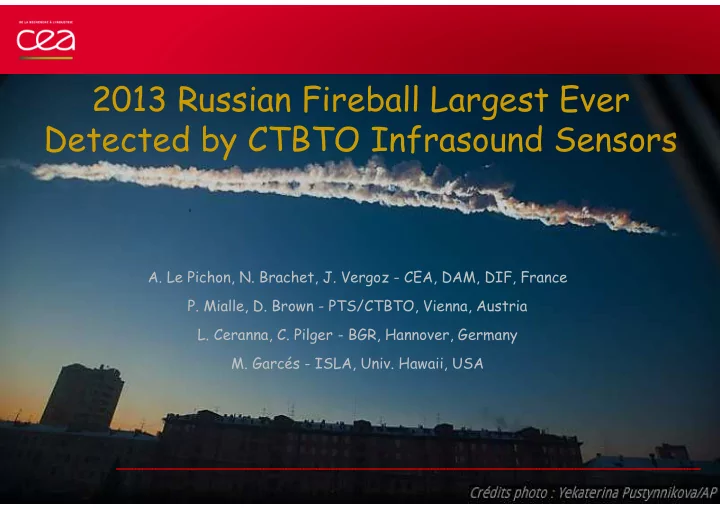

2013 Russian Fireball Largest Ever Detected by CTBTO Infrasound Sensors A. Le Pichon, N. Brachet, J. Vergoz - CEA, DAM, DIF, France P. Mialle, D. Brown - PTS/CTBTO, Vienna, Austria L. Ceranna, C. Pilger - BGR, Hannover, Germany M. Garcés - ISLA, Univ. Hawaii, USA Science and Technology Conference June 17-21 2013, Vienna, Austria
Chelyabinsk fireball, 15/02/2013 Largest ever detected by CTBTO infrasound sensors On 15 February, 2013, a large Earth ‐ impacting � fireball entered the Earth's atmosphere over the Kazakh/Russia border Maximum brightness south of Chelyabinsk � (54.80°N 61.10°E) near 30 km altitude A small asteroid at high speed (~20 km/s) � Effective diameter: ~20 m Mass: ~10,000 t Source: Univ. Western Ontario, Canada http://www.nasa.gov/mission_pages/asteroids/new s/asteroid20130215.html Science and Technology Conference June 17-21 2013, Vienna, Austria
Chelyabinsk fireball, 15/02/2013 Largest ever detected by CTBTO infrasound sensors � 20 IMS stations � 30 arrivals � Period: 20-80 s � Duration: 10 min – 3 h � Max distance: 86,600 km � Most energetic event being instrumentally recorded Science and Technology Conference June 17-21 2013, Vienna, Austria
Infrasound from meteoroids Different source mechanisms Shock wave: Meteors generate infrasound during their entry in the Earth's atmosphere. Mach cones become cylinders and generate shock waves (ReVelle D.O., 1976, 1997) Fragmentation: The high speed combined with an increasing atmospheric density, lead to thermal bursts. Energy of the explosions may reach several kilotons TNT equivalent (e.g. Edwards W.N., 2010) Propagation: Infrasound signals are refracted and channeled over long distances by the temperature gradient and the wind structure of the atmosphere Generation of hypersonic Explosive shockwaves fragmentation perpendicular event to the meteor generating a trail point source of infrasonic wave Occasionally Adapted from Ens et al., JASTP, 2012 an impact with the Earth occurs Science and Technology Conference June 17-21 2013, Vienna, Austria
Infrasound from meteoroids Example of full-wave modeling Altitude [km] Distance [km] IS24 Tahiti [1-4] Hz, 2003/12/01 Ceranna et al., 2005 Science and Technology Conference June 17-21 2013, Vienna, Austria
Chelyabinsk fireball, 15/02/2013 Detection at IS53 (Fairbanks, Alaska) @ 0.05-4 Hz Ig1 - 2013/02/15 – first arrival (6,500 km) Back-azimuth [°] Frequency 5 Pa 9:30 10:00 Ig3 – 2013/02/16 - first full circumnavigation (46,600 km) Frequency 0.1 Pa 01:00 23:00 00:00 Ig5 – 2013/02/18 - second full circumnavigation (86,600 km) Frequency � Decrease of signal frequency with distance � Almost no attenuation between Ig3 and Ig5 0.1 Pa � Limitation of the standard frequency band 13:00 14:00 15:00 16:00 Science and Technology Conference June 17-21 2013, Vienna, Austria
Chelyabinsk fireball, 15/02/2013 Detection by IS53 (Fairbanks, Alaska) 1 km Ig5 - IS53 Alaska (Ig5, 86600 km) 0.01-4 Hz, T=40 s 2 hours Science and Technology Conference June 17-21 2013, Vienna, Austria
Chelyabinsk fireball, 15/02/2013 Observations of global multiple paths Ig2 Ig1 � Barograms of phase aligned recordings at 20 IMS stations � Band-passed filter: 15-80 s Science and Technology Conference June 17-21 2013, Vienna, Austria
Chelyabinsk fireball, 15/02/2013 USArray observations 270 m/s 260 m/s 280 m/s Time after event [min] Distance to source [degrees] Courtesy of C. Degroot-Hedlin Science and Technology Conference June 17-21 2013, Vienna, Austria UCSD, USA
Chelyabinsk fireball, 15/02/2013 Global stratospheric wind circulation @ 50 km altitude ECMWF-91 profiles, � 0.5°x0.5° resolution, 91 altitude levels, http://www.ecmwf.int Dominant eastward winds � at mid-latitude in NH Weather conditions � remained relatively stable over three days Detecting stations are � uniformly distributed Science and Technology Conference June 17-21 2013, Vienna, Austria
Is It North Pole � Predicted refracting height � Range-dependent ray- Duct height [km] tracing � ECMWF-91 Is > 285 m/s It < 285 m/s � Phase identification globally consistent with the measured celerity values Brown D. et al., 2002 Courtesy of C. Degroot-Hedlin Science and Technology Conference June 17-21 2013, Vienna, Austria UCSD, USA
Chelyabinsk fireball, 15/02/2013 Attenuation vs. frequency and source altitude Source altitude: 0 km Source altitude: 30 km Upwind - It Downwind - Is Upwind - It Downwind - Is � At low frequency, the attenuation is less sensitive to stratospheric winds � Elevated source favored long propagation range Science and Technology Conference June 17-21 2013, Vienna, Austria
Chelyabinsk fireball, 15/02/2013 Example of range-dependent simulated ray paths (Ig1 and Ig2) Towards IS27 - Antarctica Ig2 Ig1 Ig2 Ig1 � Energy trapped in elevated stratospheric duct � Returned acoustic energy to the surface through diffraction Science and Technology Conference June 17-21 2013, Vienna, Austria
Chelyabinsk fireball, 15/02/2013 Example of range-dependent simulated ray paths (Ig1 and Ig3) Towards IS26 - Germany Ig1 Ig3 � Returned energy from elevated thermospheric ducts (upwind) � Phase conversion from thermospheric in NH to stratospheric in SH � Negligible absorption in the thermosphere at period near 50 s Science and Technology Conference June 17-21 2013, Vienna, Austria
Chelyabinsk fireball, 15/02/2013 Estimated yield as a function of period log W/2 = 4.14 log T - 3.61 Flux rate of NEO U.S. Air Force Technical Center From Brown et al., Nature, 2002 (AFTAC) Mean period: 39 s � Explosive yield: ~450 kt of TNT Chelyabinsk 2013 � ~450 kt Energy consistent with measured � Tunguska 1908 optical radiant energy ~10 Mt (U.S. Government sensors) Ig1 http://neo.jpl.nasa.gov/fireballs Expected to occur once every 100 � years Science and Technology Conference June 17-21 2013, Vienna, Austria
Summary � Signals produced by the 2013 Russian fireball observed at extreme ranges by 20 IMS stations � Explosive energy estimated at ~450 kt � Provide a prominent milestone for studying in detail infrasound propagation around the globe as well as for calibrating the performance of the IMS network � Provide benchmark with additional constraints on source characteristic estimates for assessing meteor impact hazard Science and Technology Conference June 17-21 2013, Vienna, Austria
Acknowledgments � P. Brown, Dpt. of Physics and Astronomy, Univ. of Western Ontario, Canada � W. Edwards, Natural Resources Canada, Ottawa, Canada � C. Degroot-Hedlin, Univ. of California San Diego, USA � L. Evers, KNMI, The Netherlands Le Pichon et al. (2013), Geophys. Res. Lett., doi:10.1002/grl.50619 Science and Technology Conference June 17-21 2013, Vienna, Austria
Recommend
More recommend